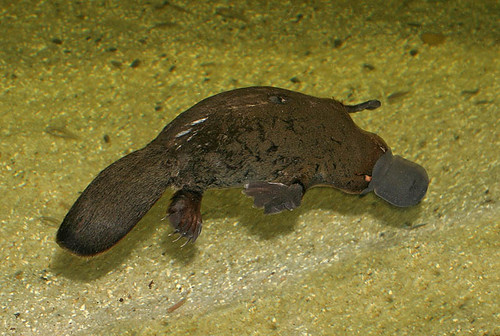
The platypus, with its duck bill and webbed feet, is a unique Australian animal. It and the echidna are the only monotremes or egg-laying mammals to be found on earth. The marsupials (mammals with pouches, e.g. kangaroos) and eutherians (placental mammals that give birth to well developed young, e.g. humans) both give birth to live young. The monotremes have lower body temperatures than other mammals and have legs which extend out, then vertically below them. These features together with their egg-laying are more like that of a lizard than a mammal. Platypus are readily identified by their streamlinedbody, webbed feet, broad tail and characteristic muzzle or bill which is soft and pliable. An adult platypus is from 45 cm to 60 cm in length and may weigh up to 2.7 kg, with females generally smaller than males. Its usual colouration is deep brown on the back and sides of the head, body and upper surfaces of the limbs. The underside is a golden colour although silky grey is not uncommon. They have two layers of fur a dense waterproof outercoat and a grey woolly underfur to provide much needed insulation. The fur on the broad flat tail is course and bristly. They have a smooth swimming action together with a low body profile and no

visible ears, making them easily recognisable in the water. It could only be mistaken for a water rat, but these have a long thin tail with a white tip.The webbed fore-paw is used for swimming, and on land, the skin, which extends beyond the long claws, is folded back to enable the animal to walk or burrow.The webbing on the hind foot does not extend beyond the bases of the claws and this foot is used mainly for steering and to tread water. The tail acts as a powerfulrudder when swimming and also aids the animal when diving. The male has a spur on the inner side of each hind limb, which is connected by means of a hollow groove to a poison gland. This spur is used to inflict wounds on natural enemies and other males, and may possibly play some part in mating. The poison is capable of inflicting a very painful injury to humans. Suprisingly, platypus are capable of many vocalisations including a soft growling sound when disturbed. The male has a spur on the inner side of each hind limb, which is connected by means of a hollow groove to a poison gland. This spur is used to inflict wounds on natural enemies and other males, and may possibly play some part in mating. The poison is capable of inflicting a very painful injury

to humans. Suprisingly, platypus are capable of many vocalisations including a soft growling sound when disturbed. Although platypus are strong swimmers they are not fast and prefer slow flowing streams. Platypus live in burrows that they dig on the banks of fresh water rivers, lakes or streams. Burrows are usually 4.5 to 9m in length, oval shaped and are constructed just above the water line, often obscured by vegetation.Platypus are solitary animals that only come togetherto mate, however, several individuals may be found living in close proximity. They are shy and wary, usually venturing out only in the early morning and evening, spending not more than two hours in the water in any one day. During that time they continually search for food, consuming up to half their own body weight a day. Grooming of the fur is very important and is carried out in the water or on land. In some areas platypus spend a surprising amount of time out of water, crossing land between tarns or dams and even foraging for worms in waterlogged paddocks. Breeding: Platypus Breeding occurs during spring but is generally earlier in the north of Australia than in the south. Mating takes place in the water and after 12 to 14 days, between 1 and 3 eggs are laid in a nesting burrowconstructed by the female. This burrow is up to 20 m long and has a nesting chamber at the end which is lined with damp plant material. The eggs are incubated between the belly and the tail of the female and hatch after 10 to 12 days. Like the echidna, the platypus lacks nipples and milk from the mammary glands oozes out through ducts at two areas on the abdomen. It is believed that the hair around these areas acts as teats that allows the young to suck the milk. By six weeks the young are furred, have their eyes open and may leave theburrow for short intervals and even enter the water. When four to five months old theyoung are weaned. Conservation status: The platypus is wholly protected throughout Australia. Although common, it requires monitoring due to the continuing degradation of suitable water bodies caused by daming, drainage and pollution. The illegal nettingof fish also causes many platypus deaths. Should the fox become established in Tasmania, the platyus could become threatened. animaldiscovery-chanel: Platypus Unique Australian Animal, Image: flickr.com
